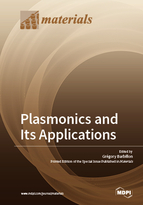Plasmonics and its Applications
A special issue of Materials (ISSN 1996-1944).
Deadline for manuscript submissions: closed (31 March 2019) | Viewed by 62216
Special Issue Editor
Interests: plasmonics; nano-optics; non-linear optics; nanophotonics; condensed matter physics; optical sensing; biosensing; nanotechnology; surface-enhanced spectroscopies; sum-frequency generation spectroscopy; materials chemistry; physical chemistry; fluorescence
Special Issues, Collections and Topics in MDPI journals
Special Issue Information
Dear Colleagues,
Nanoplasmonics is a young topic of research, and this concerns the investigation of electron oscillations, called surface plasmons, in metallic or hybrid (metallic/dielectric) nanostructures and nanoparticles. Surface plasmons have the unique capacity to confine light at the nanoscale. Moreover, these plasmonic modes are very sensitive to the surrounding medium and the materials on which they propagate. In addition to the above, the surface plasmon resonances can be controlled by adjusting the size, shape, periodicity, and materials' nature. All these optical properties can enable a great number of applications, such as biosensors, optical modulators, photocatalysis, integrated photonics and photovoltaic devices. Thus, this Special Issue is dedicated to introduce recent advances in nanoplasmonics and its applications for a wide range of topics. Therefore, it is with my great pleasure that I invite you to submit a manuscript for this Special Issue. Full papers, communications, and reviews are all welcome.
Prof. Grégory BarbillonGuest Editor
Manuscript Submission Information
Manuscripts should be submitted online at www.mdpi.com by registering and logging in to this website. Once you are registered, click here to go to the submission form. Manuscripts can be submitted until the deadline. All submissions that pass pre-check are peer-reviewed. Accepted papers will be published continuously in the journal (as soon as accepted) and will be listed together on the special issue website. Research articles, review articles as well as short communications are invited. For planned papers, a title and short abstract (about 100 words) can be sent to the Editorial Office for announcement on this website.
Submitted manuscripts should not have been published previously, nor be under consideration for publication elsewhere (except conference proceedings papers). All manuscripts are thoroughly refereed through a single-blind peer-review process. A guide for authors and other relevant information for submission of manuscripts is available on the Instructions for Authors page. Materials is an international peer-reviewed open access semimonthly journal published by MDPI.
Please visit the Instructions for Authors page before submitting a manuscript. The Article Processing Charge (APC) for publication in this open access journal is 2600 CHF (Swiss Francs). Submitted papers should be well formatted and use good English. Authors may use MDPI's English editing service prior to publication or during author revisions.
Keywords
- Plasmonics
- Thermoplasmonics
- Biosensing
- SERS
- TERS
- SEIRA
- Sum-Frequency Generation
- Metamaterials
- Graphene plasmonics
- Optoelectronics
- Plasmonic Photocatalysis







